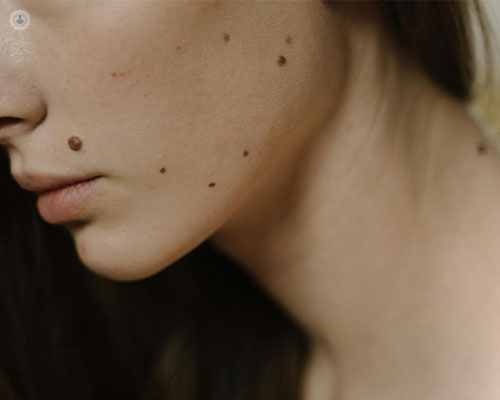All about benign moles, and how to tell when they're not
Escrito por:A mole is a textured bump, patch (macule) or nodule on the skin that is skin-coloured, darker, or differently coloured than the surrounding skin and form due to clusters of melanocytes or nevus cells. Moles are exceedingly common, and can be anywhere on the body — you’d be hard-pressed to find someone who doesn’t have at least one mole somewhere. While some moles can be cancerous, the majority are benign. In this article, Dr Minal Patel shares all about moles, going over what is normal and how to tell if something may be cause for concern.

What are moles and how can I know if they’re benign?
Moles (also known as nevi or beauty marks) appear mostly in childhood, though you can be born with them, which are called congenital nevi. They are not static marks on the body — they change over time. They can get darker or appear due to sun exposure, pregnancy, and puberty. They may get lighter with age, even to the point of disappearing entirely. Some moles may have course, thick hairs growing from or on top of them. The skin is a constantly shifting organ and changes are expected as we age, but it is a good idea to keep an eye on changing moles as there is a possibility of melanoma.
What are cancerous moles?
Melanoma is a form of skin cancer that can occur with moles, especially in larger moles or for those who have many moles. To stay aware, people should keep an eye on two or more of the following signs that a mole may be a melanoma:
- asymmetry
- ragged border
- irregular or inconsistent in colour
- a diameter larger than 6mm
- changes in size, texture, shape or colour
This is known as the ABCDE rule (asymmetry, borders, colour, diameter, evolution).
There is a kind of mole, called an atypical mole (or dyplastic nevus) that can have a lot of the characteristics of melanoma, in that they may have irregular borders, have different colours within their borders, and be quite large. Typically, they are benign, though it is important to note that a lot of them can increase the risk of melanoma and can progress to being cancerous — people who have 10 or more atypical moles are 12 times more likely to develop melanoma.
Moles should not be painful, itchy, or bleed. If these, or the ABCDEs occur to your mole, a dermatologist will need to be consulted. If the dermatologist agrees there’s a reason for concern, they might perform a skin biopsy in order to examine the composition of the mole. If it is discovered that the mole is dangerous, it will need to be removed.
How can moles be removed?
Benign moles can be removed for cosmetic reasons, or so that they can be tested for pre-cancerous suspicions. They can be removed surgically, where the surgeon will numb the area and use a scalpel to cut out the mole, leaving a gap or hole in the skin that may be cauterised or stitched closed. Another method is a shave excision, which is best for textured moles, where after numbing the area, a razor is used to shave the skin growth down to level with the rest of the skin. If there is bleeding, the site may also be cauterised. It is important to note that these methods will leave scarring, though it is minimal and can be corrected.
Textured moles can also be removed with electrical currents (electrocautery) or with liquid nitrogen (cryotherapy), but this may not remove or neutralise the melanocytes or nevus cells under the skin and the mole could regrow after time.
If you are concerned about any moles or skin markets, you can book a consultation with a specialist via Top Doctors or by downloading the MySkinDoctor appv.


